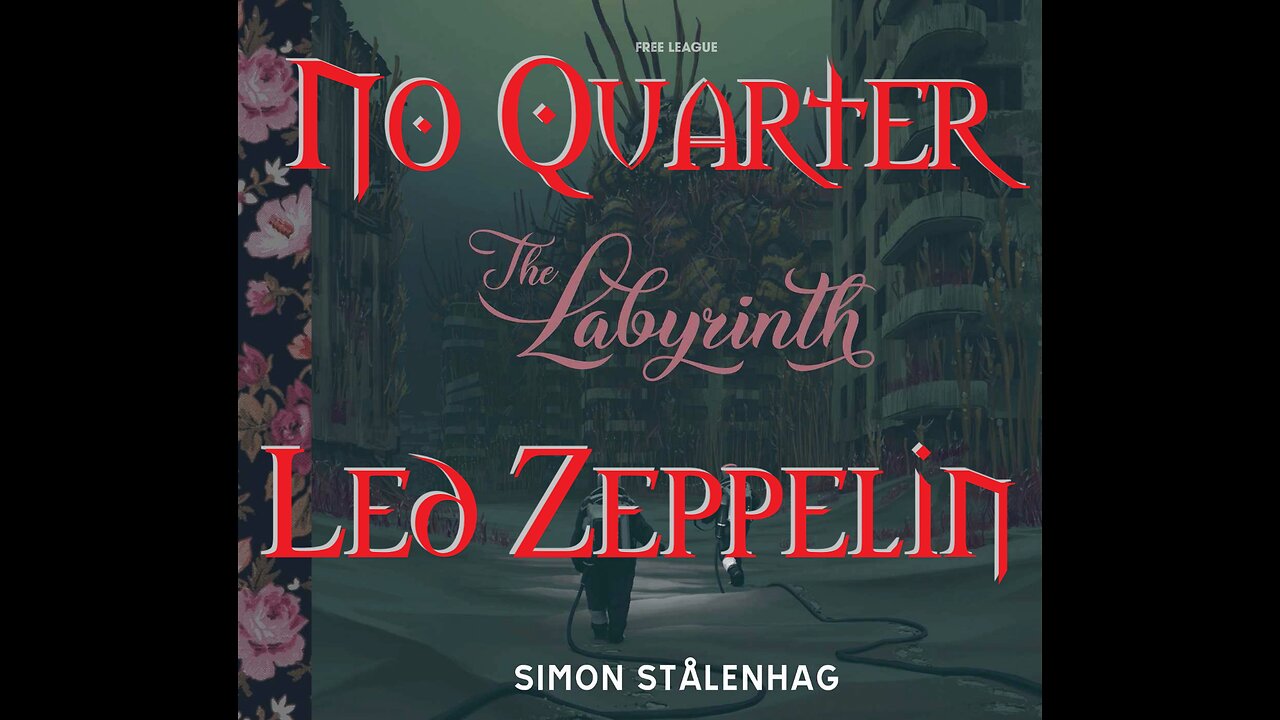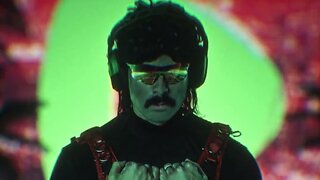Premium Only Content

No Quarter Led Zeppelin
Stålenhag spoke about his motivation behind The Labyrinth, his artistic process, and what it’s like seeing his work adapted into new mediums...
"The Labyrinth is the result of the last few years of me exploring a true post-apocalyptic setting for the first time. I did a dystopian setting with The Electric State [in 2018], and I think Tales from the Loop is almost... not utopian, but it’s definitely not dystopian. So with The Labyrinth, I really wanted to do something that was post-apocalyptic because nothing else felt relevant. Going back to the styles I’ve done in the past, it didn’t feel like I could indulge that kind of fantasy. It’s a feel-good thing, and I didn’t feel very good about the world. So doing those ash-covered landscapes was the only thing that felt relevant.
I start with the visual. It comes to me like dreams almost — that sounds pretentious — but like a vision. You get a visual idea that’s worth exploring, and then I start thinking about possible stories. I’ve seen people write stories about my pictures, and that’s pretty much what I do myself. I see the picture and then try to figure out what happens here or what could happen.
While doing that, I take a lot of notes. I usually write on the iPhones Notes app. My phone is filled with them. I write an idea for a character, then I go out for a walk and realize everything I wrote is wrong. But instead of changing that note, I make a new one so I constantly keep redoing it and trying to tell the story as a little synopsis over and over. It changes each time while I’m working on the visuals, so it’s two separate processes.
There’s a sketch phase where I do quicker sketches. I spend maybe two to three hours on a sketch so I get the colors, the composition, the tone. And then I do a series of maybe 10, 20, 30 of those with the same setting, same concept, but a progression, before I select one and spend maybe three to four days on it to make a final rendering.
In The Labyrinth, there’s all these ash landscapes. I did sketches and took photos of Stockholm and did paint-overs in Photoshop of those photos. I probably had 60 or so. It was variations on the same theme, so that became one section of the book.
Then I did all the interiors, that was a totally different process. For the interior research facility, I created very accurate 3D models of all these things, like the chairs and kitchen sink and the power sockets. I wanted it to be super real, existing stuff, super familiar. I couldn’t really do sketches because so much was depending on getting measurements.
All the painting is in Photoshop these days. I use a Wacom pen with the MobileStudio Pro. For the 3D modeling, I use an architectural program called SketchUp. For my next book, I’m using a terrain simulation tool to create sand dunes and natural patterns that are mathematically calculated. That’s something I’ve been wanting to do for a long time. Those 3D environments become a basis for a painting in Photoshop. It’s part of the job to explore new technologies to find new imagery.
I never read comic books. I wasn’t a comic book fan. When I started drawing as a kid, I was captured by paintings and naturalist painters who did very accurate renderings of birds and stuff like that. I always felt the comics I read here in Sweden were a bit sloppy. I’m just gonna shit on a whole line of work… Not that the artists were bad, but you can see they had to work fast.
I always felt like doing a graphic novel that way, where you have a lot of different panels, I couldn’t do it with the kind of accuracy I wanted in terms of getting the whole environment, the whole atmosphere, and every little detail.
To me, the environment and the mood was much more important than sequences. I also really liked poetry and stuff that has a more fragmentary dream-like quality to it. That was something that inspired me in terms of the prose. So I felt that you could probably do something with that — having these keyhole moments rendered, and having a text that is also a keyhole moment into a bigger world that you don’t get to see.
It’s almost like a short film where you get a glimpse of something bigger but you don’t spoil it by giving away too much.
Sometimes I feel like I hate my own aesthetic. I’ve seen it so much. But also, it’s so flattering to be part of an aesthetic movement and when people are influenced by my work.
It’s really a complex situation where… I always have been very personal. I can’t change that much. I try to do different things, but to do something completely different I’d have to change into a different person, and I can’t.
So I’m kind of scared that if I’m part of a trend, that trend will pass, but I won’t pass. I’m still gonna be me, and I’m getting older. I’m already thinking of those things, like I have to prepare for being irrelevant, basically, and not try to outsmart myself.
It is hard to not be affected by it, but you don’t have much of a choice when it comes to things that appeal to you.
I think most of it’s the ’80s references. I wish it was more about the personal stuff, but I think that was just good timing.
When I studied game design, one of the projects we did was create concepts for a game, and my concept was to make a game set in mid-’80s small-town America with kids on BMX bikes and the government and some alien creatures. It was very much like Stranger Things, and this was in 2008. So that was obviously something that a lot of people were thinking about. We grew up watching E.T., and everybody was nostalgic about those films and music.
There’s a weird coincidence in that it features police brutality and face masks — it has nothing to do with COVID or the protests in the US. I did it before they broke out. And that made me feel like I was afraid people might see this as a cheap exploitation of real-world events.
There are a lot of faceless enforcers of state violence. That’s a theme in The Labyrinth. While doing this, those images started pouring in from the protests in the US. When I started thinking about it, it was from protests in Spain in 2016 or 2017, I remember thinking it’s so weird that a democracy can have these thugs on the payroll to do these things.
For me, visually, that’s a crack in the facade. So I started exploring the visuals of that to design the uniforms and equipment used in the book, the scenes that featured those elements and violence. It felt really weird when I really saw stuff in the news... reality is worse than your imagination.
Ah, it’s such a broad name. There’s many Labyrinths. But it is a reason to call it Simon Stålenhag’s The Labyrinth. I always wanted that. Like John Carpenter’s The Thing. I can have my own, this is my Labyrinth. There’s a lot of labyrinths visually in this — a game this kid is playing is a labyrinth. I was aware of that legendary film, so I tried to come up with a different name. But I just felt like this is a labyrinth. It has to be The Labyrinth."
-
 10:16
10:16
Psychological operations
3 days agoHail To The King Shepherd Of Fire Avenged Sevenfold
511 -
 14:19
14:19
justintech
10 hours agoBest Gaming PC Under $2000 - In 2024
2.05K1 -
 5:09
5:09
Guns & Gadgets 2nd Amendment News
20 hours agoFBI Stops 9/11 Style Terror Attack!!
3.47K4 -
 9:39
9:39
GBGunsRumble
20 hours agoGBGuns Armory Ep 128 Kimber R7 Mako Carbon Compact
39.8K8 -
 1:00:51
1:00:51
The Tom Renz Show
18 hours ago"DEI Is Racist - Who knew & Redfield Now Worries About COVID Jabs"
38.6K4 -
 5:01
5:01
BIG NEM
11 hours agoInside the Albanian Mob... As a Serb.
17.1K2 -
 1:40:14
1:40:14
TheConnieBryanShow
4 days agoGAIN OF FUNCTION: MRNA, D.A.R.P.A. & THE PFIZER PAPERS
15.6K4 -
 2:14:01
2:14:01
Fresh and Fit
7 hours agoDr. Disrespect Moves To Rumble!
66.4K32 -
 6:14:53
6:14:53
Akademiks
10 hours agoDrake Sued his Label for Botting Kendrick Lamar Streams to 'End Him'. Kendrick Drops new video!
74.8K12 -
 0:46
0:46
Dr Disrespect
16 hours agoIt's not just a stream... it's an experience
342K1.76K